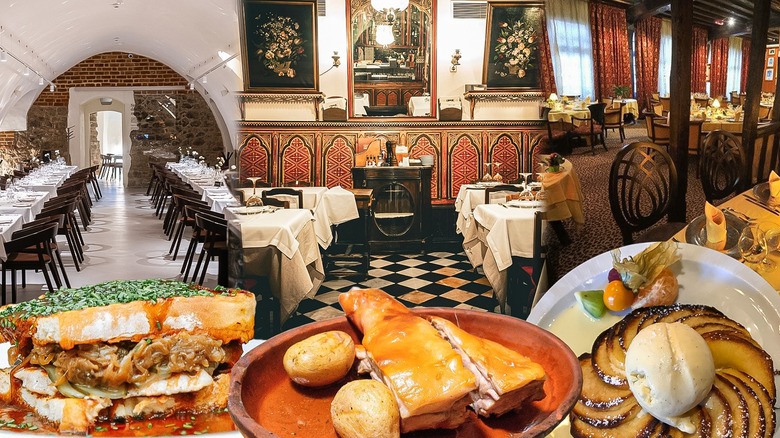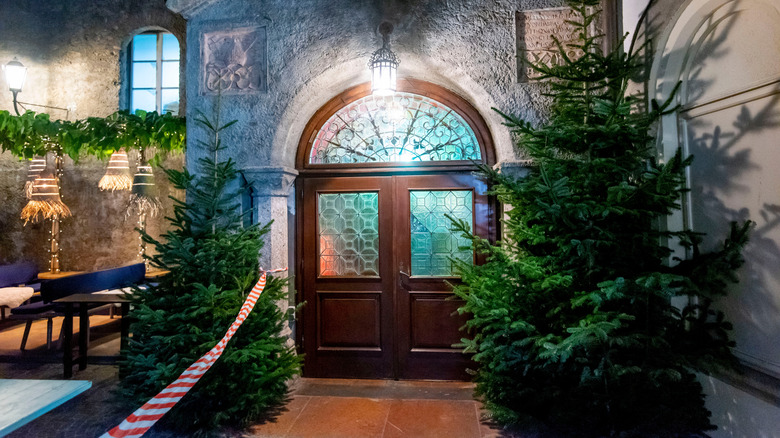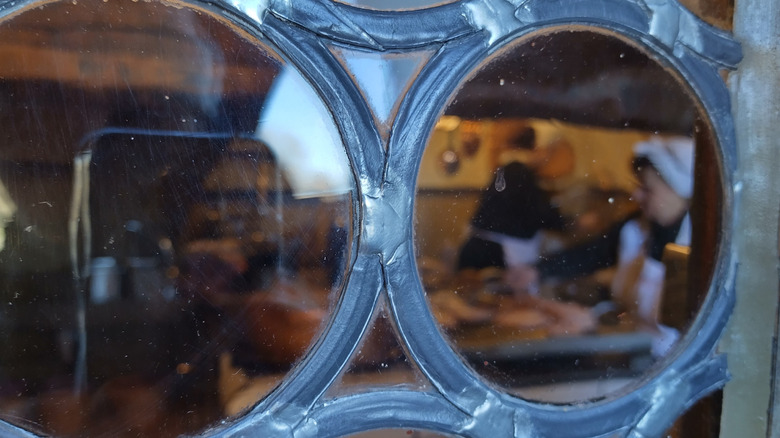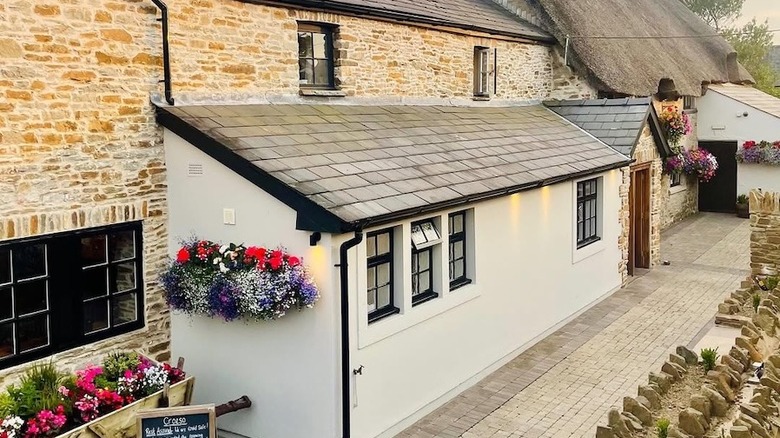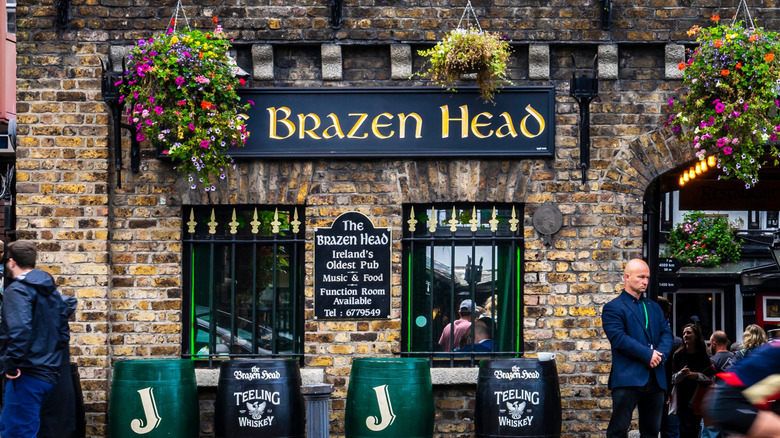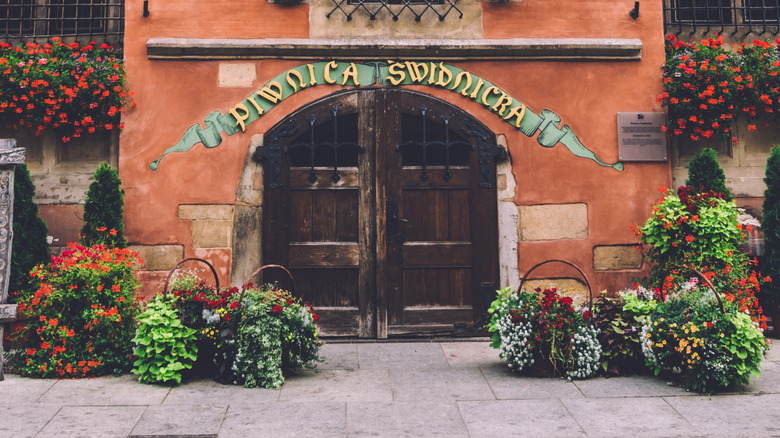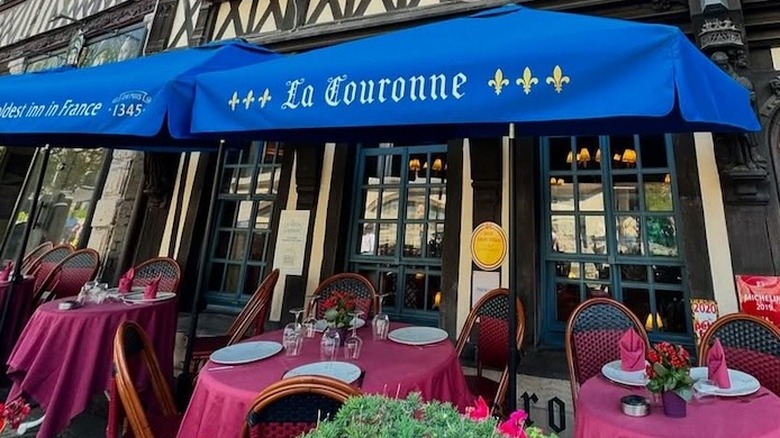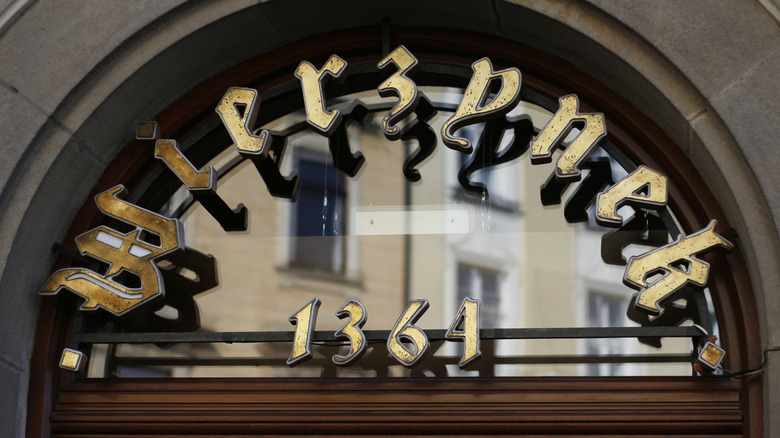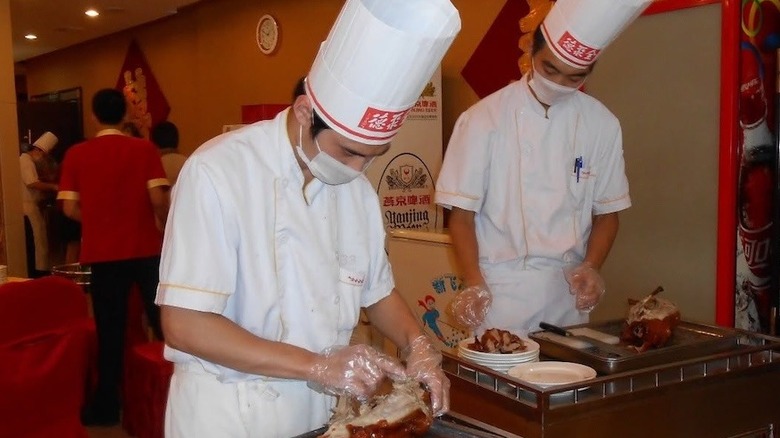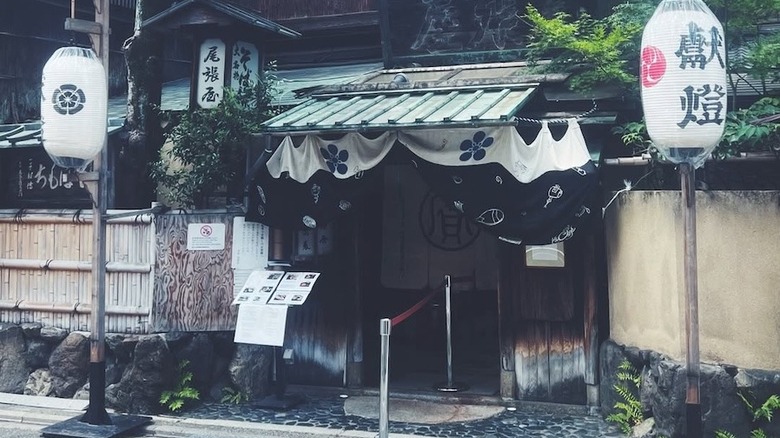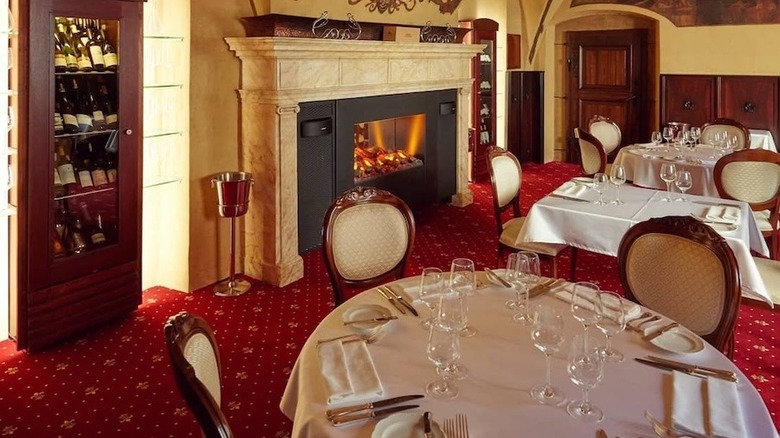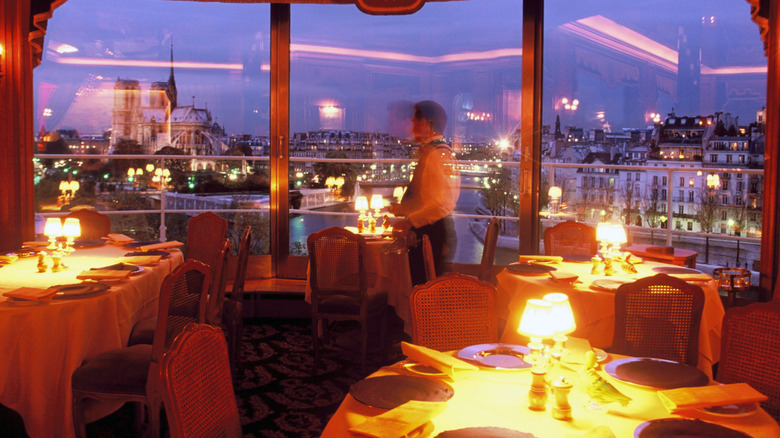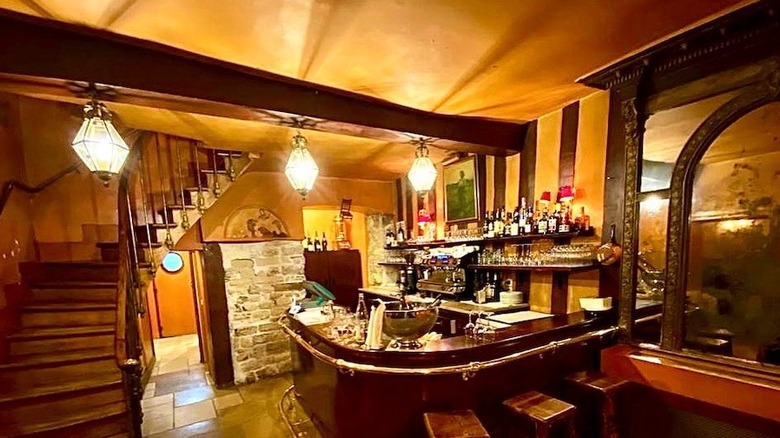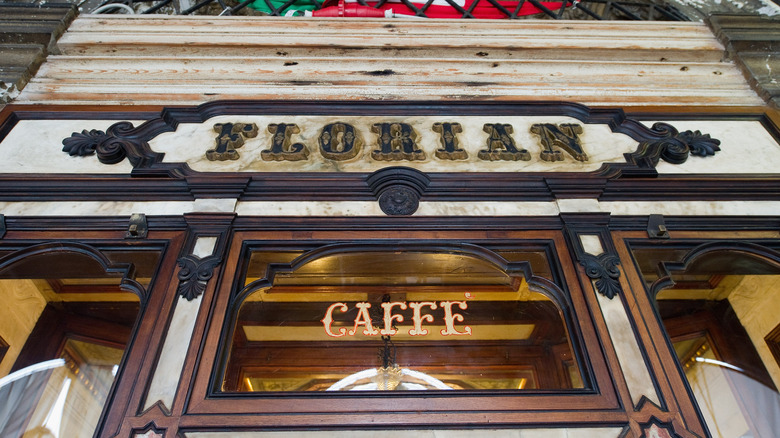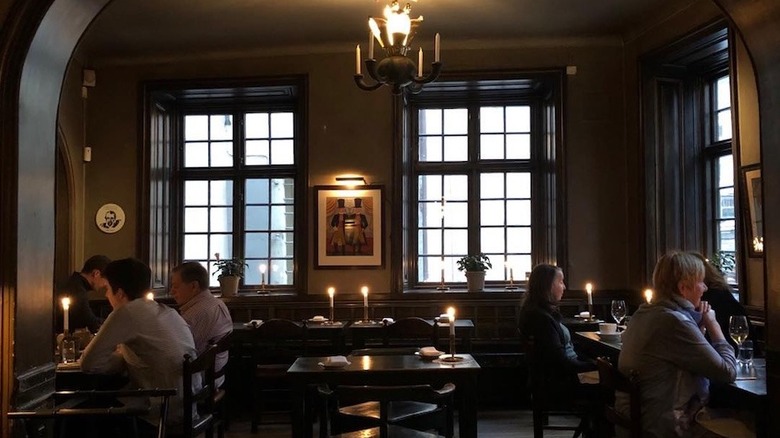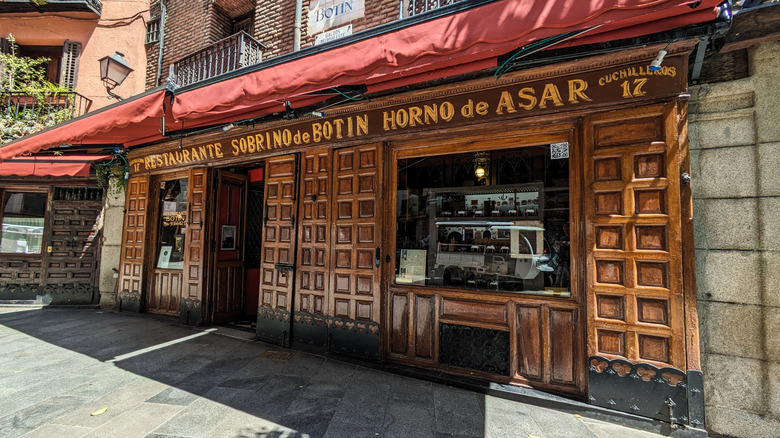15 Of The Oldest Restaurants On Earth
Everybody knows an old place, that food spot that's supposedly been around since their town has existed, the kind of places rich with history and lore. But most of the oldest restaurants in every state in the U.S. aren't even close to being the oldest restaurants in the world. Many European and Asian nations were settled and settled into centuries ago, and as the people needed to eat (and often, drink, socialize, and gather), so restaurants opened up to give the people what they wanted.
Restaurants have since become highly sophisticated endeavors. And yet some stalwarts of the past, time capsules and windows into history of how people used to prepare, serve, and eat food, remain, steadfastly refusing to close or even change as generations pass through and the centuries wear on. Here, then, are 15 of the absolute oldest, most certifiably legendary restaurants around the world that opened hundreds of years ago and are still serving today.
St. Peter Stiftskulinarium
While it's believed to be the oldest restaurant at least in Europe, there's a chance that St. Peter's Stiftskeller is even older than historical records indicate. When it was operating a full service inn, it was noted in surviving documents of Alcuin of York, an advisor to the emperor Charlemagne, which date back to the year 803. The restaurant is adjacent to what was once St. Peter's Abbey in Salzburg, Austria, and it's now a popular fine dining locale and stylish nightlife spot that regulars simply refer to as Peter.
St. Peter Stiftskulinarium is partitioned into 11 different dining rooms that each give a nod to Austrian history, as does the wine cellar left over from when the building housed a monastery. The menu includes classic, Austrian dishes that are old, but maybe not as old as the restaurant itself, such as tafelspitz or boiled local beef, and wiener schnitzel made from veal. Each year, the restaurant hosts a Mozart dinner in honor of Salzburg's most famous resident, serving food and wine that may have been served in 1790, when St. Peter Stiftskulinarium was already nearly a millennium old.
Historische Wurstkuche
Regensburg, Germany, north of Munich, is the farthest point north that the Roman Empire ever stretched. The medieval town still has a standing 12th century bridge built by workers fueled on Bavarian-style sausages, most of them made in a sausage kitchen, or wurstkuche, which operated out of the construction office. That provider of sausages is still in business, in a building constructed in the 17th century, mainly as a takeout joint, where it still makes and sells about 6,000 sausages today.
It's still in the family that purchased it in 1806 from the Regensburg government. Documentation indicates that the operation, which adopted the name Historische Wurstkuche (historic sausage kitchen) was open at least as early as 1146. The best thing to eat at the Wurstkuche: the sausages, of course. The prices are at a low, fast food level, like two bratwursts in a bun for about $3, or a plate of half a dozen sausages for the equivalent of about a dollar each.
The Old House
U.K. pubs are in need of saving, and that threatens the ancient culture surrounding the gathering houses where for hundreds of years, locals have met to drink and socialize. With the closure of the 1,000-year-old British pub Ye Olde Fighting Cocks in 2022, one of the oldest extant public houses in the whole of the U.K. is the appropriately named The Old House in the remote and pastoral village of Llangynwyd, Wales.
Still operating as a real and full pub in that the small bar and restaurant also offers a few rooms to stay in for the night, the classic fare on offer at The Old House is the main attraction. There's lots of fish, with chips and without, along with meat pies, lamb, Welsh rarebit, and sticky toffee pudding. In the 2020s, new owners restored the property to look like it may have in its heyday, keeping the fireplaces, stone walls, and thatched roof around.
The Brazen Head
Guinness supposedly tastes better in Ireland, the place of its origin, and the airy stout is one of many beers on tap at The Brazen Head, a pub in Dublin that's been pouring them out since the year 1198. The Brazen Head's signature brew is the Brazen Lager, made just for the pub with a yeast strain specially developed for the purpose.
While services were offered on the site since the late 12th century, the Brazen Head didn't start going by that name until around 1653, and the building that houses the current iteration of the business was built in 1754. Ireland didn't create the laws to license establishments for the selling of alcoholic beverages until 1635, meaning the Brazen Head illegally sold booze for more than 400 years. As ever, the Brazen Head sells an extensive menu of classic bar and comfort food linked to the islands of western Europe, such as fish and chips, seafood chowder, bacon and cabbage, and bangers and mash.
Piwnica Swidnicka
One wouldn't know from the unassuming street level exit just how big the subterranean Piwnica Swidnicka truly is. Stretching out to almost 10,000 square feet, the 10 dining rooms of the restaurant are all underground, situated in rustic, rocky, tunnel-like rooms. Classified as the oldest city inn on the planet, it began serving guests back in 1273 with a simple menu of little more than beef and beer, which was brought into the restaurant through a tunnel from the on-site brewery, built in 1519.
Piwnica Swidnicka (which translates to "Swidnicka Cellar") is technically in the basement or cellars of what was once the town hall of the Polish city of Wroclaw. It survived a World War II bombing, still rocks the Art Nouveau style adopted in 1904, and operates as a large event space, a restaurant serving a limited menu of Polish dishes, and a beer hall. The original brewery ended production centuries ago, but owners started it back up in 2022.
La Couronne
Its full name is L'Auberge La Couronne, and it overlooks the Vieux Marche in the city of Rouen. Opening in 1345, with a publicly displayed document from the era proving it, the operation was at first a modest and nondescript pub and inn serving townsfolk and travelers, situated a few feet from the town marketplace, site of a farmers' market and where Joan of Arc was executed in the 15th century. La Couronne, now the oldest food-selling establishment in all of France, was originally just called Inn, then it was l'Hotel de la Couronne, and then it found its current name.
Rouen became a major food city home to some of most esteemed restaurants in the classical French style in part thanks to the pioneering efforts of La Couronne. The eatery's trout once helped pack the house, while today the most famous dish is the duck, served in La Couronne's sunken dining room, or in one of the five other rooms on multiple levels that can accommodate intimate meals or large gatherings. It also presents rotating prix fixe menus, like a Normandy-themed one, seasonal collections, and one consisting of entrees made famous by American-born French chef Julia Child.
Wierzynek
Standing in Krakow's Old Town neighborhood amidst a veritable sea of restaurants and bars stands Wierzynek, not only the second-oldest restaurant in Poland, but also one of the city's fanciest. It's never not been a luxurious place to dine — the restaurant started out a permanent outgrowth of a special feast attended by the royal families of Europe held in 1364 at the behest of King Casimir the Great. Local merchant Mikolaj Wierzynek put together the event to celebrate the wedding of the king's granddaughter to Luxembourg's Emperor Charles IV.
Now a sprawling complex of well appointed dining rooms, each with its own theme and adorned with artwork by famous Polish artists, on the menu are dishes inspired by traditional Eastern European and Polish cuisine, like wild boar dumplings, the perfectly imperfect comfort food of potato dumplings, smoked deer haunch, and cabbage. High-end restaurant-type desserts are sometimes on offer, too, ranging from apple tarts and Krakow's cream cake to porcini ice cream.
Bianyifang
Peking duck, a preparation that pairs crispy-skinned and juicy roast fowl with cucumber, scallion, pancakes, and sweet bean sauce, is one of the most notable foods to ever emerge from China and dates back to the 13th century. It was a relatively new concept, then, when Bianyifang opened in 1416. The restaurant in the Caishikou neighborhood of Beijing was the first roast duck eater in the city, and became the oldest restaurant in China, serving only the wealthy and high-ranking members of dynastic governments at first. By the 19th century, roasted duck was more affordable to the masses, and numerous other restaurants inspired by Bianyifang popped up around China.
The menu at Bianyifang has changed and expanded over 600 years, but it remains intensely focused on roast duck prepared in a hanging style in a closed oven, and Peking duck. One of the satellite Bianyifang restaurants even operates a Peking duck museum.
Honke Owariya
There are multiple Owariya outlets around Kyoto, one of the 10 largest cities in Japan, but Honke Owariya — literally "original Owariya" — is the oldest by far. That flagship outlet opened up in 1465, and was the place to go for cakes and other sweet treats. After more than 200 years in business, the cook in charge in 1702 tentatively added buckwheat-based soba noodles to the menu. Soba is a key ingredient in the perfect bowl of ramen, and that became the more popular avenue, so savory dishes became the main thing that Owariya prepared and sold. It still makes desserts, though, as well as buckwheat cookies, crackers, and mochi.
The favorite noodle shop for generations of the Japanese Imperial family, Honke Owariya has never expanded into the much larger Tokyo metropolis. This is because the dashi — fish stock vital to its noodle and soup dishes — can't be replicated outside of Kyoto, because the water is too different from the spring well water used for centuries.
U Maliru
This restaurant and bar space in Prague, Czechia, used to share a wall with a rampart of a monastery, until 1543 when a painter named Sic bought it, turned it into a secular gathering spot, and renamed it U Maliru, or "At the Painter's". U Maliru was completely rebuilt by new owners in 1607 and then again around 1700, upon which it was renamed U Bileho Kohouta, or roughly "At the White Cockerel." Once more renamed, going back to U Maliru, the spot really did became a place for painters, as well as other artists and fringe-dwellers, to congregate, because the restaurant offered a wide selection of wines from the Moravian region of what was then known as Czechoslovakia. The more cash-strapped clientele were allowed to pay in trade, which is why to this day U Maliru is decorated with so much original art.
Also equipped with high ceilings painted with Renaissance-style scenes, food from Czechia is on the menu, as is a lot of wine and many classical and quintessential French selections. U Maliru specializes in tableside services like flambé and meat carving, along with French offerings such as foie gras, salad nicoise, duck confit, and chocolate mousse.
La Tour d'Argent
In 1582, a Parisian known only as Rourteau set up an inn to explicitly serve the lords of France in service to King Henry III. Upscale and well-appointed, Rourteau named his upper-crust house of drinks, food, and lodging after the nearby Chateau de la Tournelle, calling it Hostellerie de la Tour d'Argent. An influential restaurant because of the powerful and wealthy people to whom it catered, the business — whose name would eventually be shortened to just La Tour d'Argent — introduced to France, and other high-end Paris restaurants an Italian eating utensil known as the fork. That made the eatery the hippest spot in town in the late 16th century.
Today, La Tour d'Argent's restaurant space occupies the sixth floor of a tower, offering views of Paris landmarks and the River Seine. The food is still decidedly French, fancy, and expensive, and the open kitchen carefully prepares a wide range of small, perfect bites made from exquisite ingredients.
La Petite Chaise
Sometimes regarded by food critics as so outwardly and performatively French that it's turned into a restaurant that markets itself as a place for American tourists to check out while visiting Paris, Le Petite Chaise is actually just very authentic. While the environs of the restaurant, which opened as an inn and a pub for travelers, are classy but homey – white tablecloths under fine china are overlooked by shelves bearing old books and knick-knacks; wood and stone are everywhere – the food is more often than not rustic, simple, and very affordable. After an appetizer of an egg and mayonnaise, celery remoulade, or onion soup, diners can move on to something like duck confit, beef tenderloin, or hand-trimmed beef tartare.
The second-oldest dining establishment in Paris, the restaurant whose name translates to "The Little Chair," is very old, but it's unclear exactly how old. Some records say the place fired up its kitchens in 1680, while others put the date at 1700.
Caffe Florian
In the storied and dense world of cafes in Venice, the oldest one, and still largely intact from its heyday, is Caffe Florian. If an important European writer found themselves in Venice, they'd categorically pop into Caffe Florian for a drink, a bite, and lively discussion; Charles Dickens, Lord Byron, and Goethe were all regulars at the café, open since 1720.
Boasting Art Nouveau architecture and a number of rooms, or halls, whose walls are lined with art, It's also seemingly the place to go for tourists. Quintessential and picturesque, Caffe Florian is usually flooded with picture-taking tourists who don't balk at the very high prices, including an extra charge to sit on the patio while musicians play. In 2019, the historic restaurant survived actual flooding but stayed open in the end, and its formally dressed staff continued to serve coffee, tea, sweets, snacks, and simple entrees from its extensive menu.
Den Gyldene Freden
The elder statesman of all Swedish restaurants, Den Gyldene Freden stands on a site in Stockholm that was previously home to a wine and beer bar, established in 1485. Lore suggests that after more property was acquired by later bar owners, Den Gyldene Freden opened in earnest in 1722. Over time, Den Gyldene Freden acquired the status of the most famous restaurant in Sweden, as "The Golden Peace" is a legendary hangout spot for the nation's most important artists and authors.
Devoted to preserving and sharing Swedish food traditions, the bill of fare consists of dishes made from supplies acquired from around the country's farms and wild areas. The menu necessarily changes seasonally, but diners can almost always expect to find a meal that includes smoked fish, exotic onions, pickled ingredients, lingonberries and cloudberries, and root vegetables, as well as entrees like veal, short ribs, and Swedish meatballs.
Botin
Because it's operated in the same space in Madrid, and hasn't endured any major name changes or significant interruptions in service, and still prepares the same kind of food that it always has, Spain's Botin proudly proclaims itself to be the oldest restaurant on the globe — despite opening in 1725, far later than most of the other eateries on this list. It's even listed with Guinness World Records as such. Taking up four whole floors, Botin maintains an 18th-century look and feel, accomplished through regular refreshes over the years.
Not only one of the oldest restaurants ever, Botin is recognized as one of the best, particularly because of two of its signature dishes prepared in an old-world fashion: suckling pig and Castilian-style roasted lamb. Those items, and many more, are prepared in a wood oven that's more than 100 years old. The menu still bears the signature of Botin's founder and cook, Jean Botin, trained in the French traditions.
